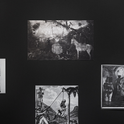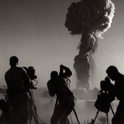If you were young and passionate about comics in the late 90s (living in, say, semi-rural East England), you were bound to live a frustrated existence. American comics could only be found in comic shops—and comic shops, if you ever caught sight of one, had the forbidding, black-windowed aura that usually accompanies a dodgier kind of entertainment outlet. Amid the science fiction shelves in book shops, you might have found a trade paperback of Neil Gaiman’s Sandman series (always volume 4, 7, or 9—hardly ever 1), and after years of striving you might read the entire Sandman saga, but out of chronological order, and with such long gaps between volumes that nothing had a chance of making sense. If you visited a library and asked for the “comic section” (as I once did) you would get a frown, maybe even a sneer, and perhaps an uncertain finger pointed towards the children’s shelves.
Nowadays an avid reader of comics will have less difficulty finding them. If a library is still standing, it will have a range of comics, and they will be among the most popular items on the shelves. Chain bookshops have now given comics their own section, sometimes in a more prominent place than general fiction (and the complete Sandman is always in stock).
Attitudes have evolved, too. Switch on Radio 4 and you’re in danger of hearing high-minded critics trying to make sense of Chris Ware’s Building Stories. Even more remarkably, it has been announced that this year’s Costa Prize includes two comics among the nominations: Joff Winterhart’s Days of the Bagnold Summer and Mary M and Bryan Talbot’s Dotter of her Father’s Eyes, nominated for the novel and biography categories respectively. No longer ghettoised, comics are making a play for the centre ground.
Except hardly anyone calls them comics now. They call them graphic novels. It’s an ugly construction, and too persistent to ignore. It also signals something important: one of the most beleaguered and underappreciated forms of popular culture has undergone a torturous rebranding process, starting in the 80s and reaching fruition in recent years. What have we lost in the transition?
The term “graphic novel” was popularised by Will Eisner, one of the first comic creators to write seriously about the medium. Initially he had used the term to make his standalone comic book A Contract with God (1978) more palatable for publishers. Calling his comic books “graphic novels” might increase his chances of being published by a major house, he thought. This tactic didn’t work—Bantam Books, his first choice of publisher, rejected the comic after seeing that it was, in fact, a comic.
Soon after, the “graphic novel” tag began to take on more meaning for Eisner. He was serious about comic books being treated as a literary form, distinct from novels but equally worthy of consideration. Eisner’s intention was to propel them out of the newsstands and into the libraries. The word “comic” was a misnomer—as he put it in a 2002 lecture, “We can't get rid of the thing… It doesn’t belong here and it's partly our fault because comics originally were designed to be funny stories. They were originally called ‘the funnies’ and called ‘the jokes,’ and later on ‘the comicals.’ The name kind of stuck.” He went on to say something more ominous: “In order for the medium to grow and mature as it has been, it needs the attention and the interest of people who, in the academic world, are able to dissect it, to discuss it, to recognise it, and to evaluate it.”
Some writers and readers might balk at this desire for academic acceptance. But Eisner believed that serious art needs serious cheerleaders. Left in the hands of sweaty-palmed fanboys, comics would never claim their rightful place. Eisner is entitled to use “graphic novel” to describe the vaulting ambition of his own work. The problem comes when a unique tag bleeds into the general culture, so that a whole form is then defined by one person’s eccentricity.
And as we have recently seen, calling comics “graphic novels” can lead to confusion. Robert Macfarlane, chair of the 2013 Man Booker prize, stated that he would welcome graphic novel submissions from publishers, saying that novels by Dickens and Wilkie Collins were “heavily illustrated when they were published in the 19th century.” The implication here is that graphic novels are novels with a bit of doodling—exactly what Eisner’s phrase suggests. Yet comics have their own tradition, which is probably older even than the novel form. Scott McCloud, in his essential Understanding Comics (1993) traces the source back through the Bayeux tapestry and beyond. Modern comics are formally closer to Ancient Egyptian painting than they are to Victorian illustrated novels.
Alan Moore, co-creator of Watchmen (1986-87) and V for Vendetta (1982-89), holds views that are at odds with Eisner’s. In a 1985 essay, he wrote, “Rather than seizing upon the superficial similarities between comics and films or comics and books in the hope that some of the respectability of those media will rub off upon us, wouldn’t it be more constructive to focus our attention upon those ideas where comics are special and unique?” He has often been critical of the waves of superficial respect that occasionally lap against the shores of geekdom. For Moore, the offer of mainstream acceptance is always a poisoned chalice. The raucous potential of comics can only be realised when it is uncontaminated by malicious—and commercial—influence.
What is happening with comics is a microcosm of popular culture as a whole. In the literary sphere, there are now constant skirmishes surrounding the question of genre and respect. Many established crime and thriller novelists, including Peter James and Lee Child, seem to desire literary acceptance above all else. Recently, to the consternation of some art critics, the Museum of Modern Art in New York announced it would exhibit 14 video games as part of its architecture and design collection. In 2010, Yale University Press published the Anthology of Rap, a collection of rap lyrics printed—and celebrated—as poetry. Everything that used to signify “wasted youth” now signifies “overlooked genius.”
But to elevate—or, perhaps, to relegate—fringe artistic forms to institutional positions is not always the best way of honouring them. For one thing, it’s always too late. For another, it rarely improves the quality of the work. Almost a hundred years ago, a comic strip like George Herriman’s Krazy Kat had a modernist, surrealist sensibility while being accessible to a general audience (and nearly invisible to literary culture). Masterpieces such as Art Spiegelman’s Maus (1986-91) and the Hernandez brothers’ Love and Rockets (1982-present) arrived at a time when the mainstream didn’t expect anything of comics. To some extent, their impact was a product of neglect. Now that comics are under a brighter spotlight, it’s difficult to tell whether they will continue to develop or move into a more comfortable recycling mode, displaying the qualities that latecomers might have missed the first time round. The quality of comic books overall has not diminished so far (although mainstream superhero comics have been dead in the water for decades), but certainly the sense of unpredictable energy has wavered. Breaking new ground is hard when there are a thousand cultural critics waiting to judge your work not against comics of the recent past, but against their own inexpert prejudices and standards.
There is, I admit, always an element of the possessive weirdo in this attitude. Once you’re part of a subculture, it can be difficult to shake a sense of fealty. Last month, the comic artist Tony Harris showed just how possessive and weird it’s possible to get when he hammered out a misogynistic rant on his Facebook wall, raging against “cosplay” girls (who dress up in costumes) and their presence at comic book conventions. Giles Coren’s ostensibly harmless opinion piece for the Spectator, on why comics shouldn’t be nominated for literary prizes, provoked more vituperation in the online comments than seems rational (as a rule, comic fans and the internet do not mix well). But lovers of the medium need to resist the urge to settle scores. Nothing the literary establishment does will make up for lost time, and we don’t need anyone’s permission to recognise great works of art.
The C word
Comic books are out of their ghetto—but critical acceptance comes with a price
December 20, 2012












